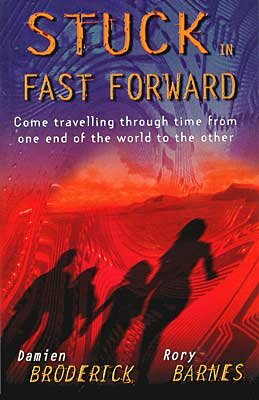|
Stuck in Fast Forward - Damien Broderick & Rory Barnes
HarperCollins Australia, July 1999, pb, 227pp, $12.95. Cover by Luke Causby.
Reviewed by Jonathan Strahan
 Damien Broderick and Rory Barnes' previous collaborative novel, Zones, told of a young girl who received telephone calls from a different time. In their latest, Stuck in Fast Forward, the authors spin an enjoyable if somewhat episodic yarn about space-time theory, the rapid pace of technological change, and what to do when your annoying kid sister grows older than you. Damien Broderick and Rory Barnes' previous collaborative novel, Zones, told of a young girl who received telephone calls from a different time. In their latest, Stuck in Fast Forward, the authors spin an enjoyable if somewhat episodic yarn about space-time theory, the rapid pace of technological change, and what to do when your annoying kid sister grows older than you.
Convinced that a plague is about to bring about the end of the world, Natalie's dad tries to pack his family into a time machine that he has built in the garage - a bubble in space-time called a "vacuole" that will allow them to skip into the future. Things go slightly awry when Nat's kid sister Fiona refuses to go, snatching the family dog Ferdinand and running away at the last moment. When the family emerge from the vacuole a few minutes later they find that more than a year has passed, and that Fiona is now a harder and wiser young woman having lived through the plague. Realising that things are not yet safe enough, the family jumps into the future, stopping to pick up a cute guy along the way, before jumping again and again through time in search of a future they can live in.
Stuck in Fast Forward is closely tied to the work that Broderick did in his 1997 work of nonfiction, The Spike: Accelerating Into an Unimaginable Future. In The Spike Broderick looked at the exponential and uncontrolled rate of technological progress, and suggested that by 2020 computers would be as smart as people, and by 2050 they could be in control. The "spike" of the title referred to the peak you would see if you drew a chart showing the rate of technological change. Broderick and Barnes go to some trouble to establish the link to The Spike - at one point Natalie even refers to Broderick as "a mad friend of theirs [who] had written a book about this Spike." Stuck in Fast Forward reflects the spike on almost every level. Characters observe its after-effects firsthand, jumping forward in time in exponentially longer leaps, heading towards a kind of chronological/experiential spike of their own.
For all that Stuck in Fast Forward considers weighty issues, it never lectures and is never dull. There are some genuinely spooky moments - especially when Natalie prepares to enter the time machine for the first time - and some very funny ones. Like all good collaborations, Stuck in Fast Forward exploits the strengths of both authors to overcome their respective weaknesses. Broderick's impressive grasp of science and sly wit combine with Barnes' warmth and immediacy to produce one of the more enjoyable young adult SF novels of recent times.
©1999 Jonathan Strahan.
This review originally appeared in Locus. |
 |

|

